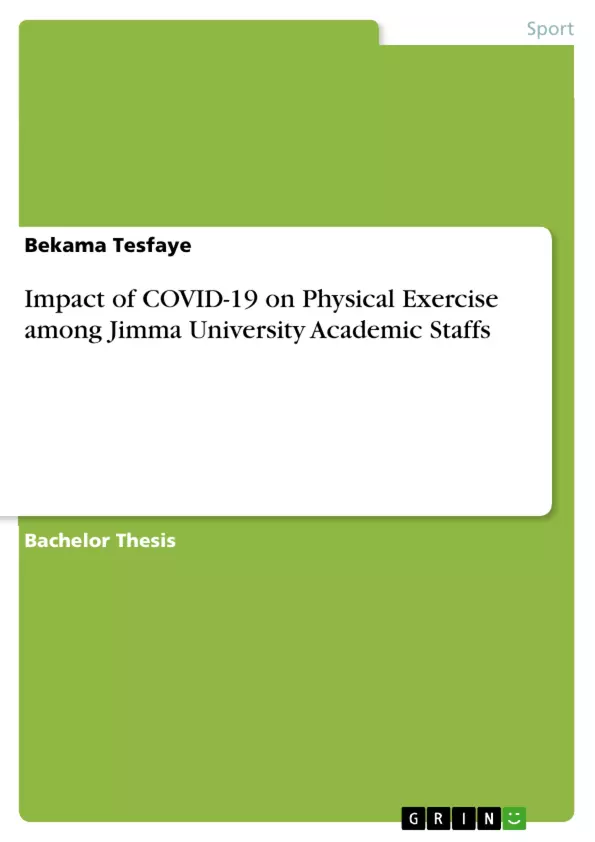The major objective of this study was to describe the impacts of COVID-19 on PE among JU academic staff. The descriptive cross-sectional study design was applied to research by using a convenience sampling technique to collect data from 333 academic staffs of JU and the analysis was conducted with descriptive statistics (frequency, percentage) and inferential statistics (correlation (Bivariate)).
World health organization (WHO) set up a routine to be active every day, by planning a Physical Exercise(PE)or exercise break either by yourself, by joining an online class, or by setting up a time to be active online with your friends or colleagues. Jimma University|(JU) staff were adapted to perform physical activities at the Fitness center, Stadium, and Gymnasium; these all were closed by government decree because of COVID-19 Pandemic.
Inhaltsverzeichnis (Table of Contents)
- ACKNOWLEDGMENT
- TABLE OF CONTENTS
- ABBREVIATIONS
- ABSTRACT
- List of tables
- CHAPTER ONE
- INTRODUCTION
- 1.1 BACKGROUND OF THE STUDY
- 1.2 STATEMENT OF THE PROBLEM
- 1.3 OBJECTIVE OF THE RESEARCH
- 1.3.1 GENERAL OBJECTIVE
- 1.3.2 SPECIFIC OBJECTIVES
- 1.4 SIGNIFICANCE OF THE STUDY
- 1.5 DELIMITATION OF THE STUDY
- 1.6 LIMITATIONS OF THE STUDY
- 1.7 OPERATIONAL DEFINITION OF KEY TERMS AND ABBREVIATIONS
- 1.8 ORGANIZATION OF THE REPORT
- CHAPTER TWO
- LITERATURE REVIEW
- 2. 1. CONCEPT OF COVID-19
- 2.2 CONCEPT OF PHYSICAL ACTIVITY AND PHYSICAL EXERCISE
- 2.3. PE, SEDENTARY LIFE AND COVID-19
- 2.4. SEDENTARY LIFE AND CONSEQUENCE
- 2.5. HOME BASED PHYSICAL EXERCISE
- 2.5.1 HOW TO PARTICIPATE IN INDOOR ACTIVITIES
- 2.5.2. OUTDOORACTIVITIES DURING COVID-19
- 2.6 Planned Physical Activity prescribed during self-Isolation
- 2.7 Immunity and Physical Exercise
- CHAPTER THREE
- METHODOLOGY
- 3.1 STUDY AREA
- 3.2 STUDY DESIGN AND METHOD OF DATA COLLECTION
- 3.3 DATA COLLECTION
- 3.3.1 QUESTIONNAIRE
- 3.4 STUDY POPULATION
- 3.5 SAMPLE SIZE AND SAMPLING TECHNIQUE
- 3.6. Study variables
- 3.6.1. Dependent variables
- 3.6.1. Independent variable
- 3.7 DATA ANALYSIS AND INTERPRETATIONS
- 3.8ETHICAL ISSUE
- CHAPTER FOUR
- RESULTS AND DISCUSSION
- 4.1. Demographic characteristics of the respondents
- 4.2. Engagement in Physical Exercise during the period of COVID-19 pandemic.
- 4.3 Engagement in PEP re and during State of emergency due to COVID 19
- 4.4 Pattern of engaging in physical exercise before the state of emergency due to COVID-19 in terms of the number of days per week.
- 4.5 Pattern of engaging in physical exercise during the state of emergency due to COVID-19 in terms of the number of days per week.
- 4.6 Pattern of engaging in physical exercise before the state of emergency due to COVID-19 in terms of the number of hours per week.
- 4.7 Pattern of engaging in physical exercise during the state of emergency due to COVID-19 in terms of the number of hours per week.
- 4.8 Type of disease diagnosed among Jimma university academic staffs during a time of COVID 19.
- 4.9 Types of Physical exercise joined During COVID 19
- 4.10 Challenges that have been tackled During COVID 19 to participate in physical exercise.
- 4.11 Correlation between days and the hours spent on physical exercise pre and during period of pandemic (COVID 19).
- 4.12. How the university and staffs could minimized the challenges that seen in the pandemic period.
- 4.13 Discussion
- CHAPTER FIVE
- SUMMARY, CONCLUSIONS, AND RECOMMENDATIONS
- 5.1 SUMMARY
- 5.2 CONCLUSION
- REFERENCES
- APPENDIX
Zielsetzung und Themenschwerpunkte (Objectives and Key Themes)
This research paper investigates the impacts of the COVID-19 pandemic on physical exercise among academic staff at Jimma University. The study aims to understand the changes in physical activity patterns, challenges encountered, and potential solutions for maintaining exercise routines during the pandemic.
- Changes in physical activity patterns during the COVID-19 pandemic
- Challenges faced by academic staff in maintaining physical exercise routines
- The impact of COVID-19 on the health and well-being of academic staff
- Strategies and solutions for promoting physical activity during the pandemic
- The role of the university in supporting academic staff in maintaining healthy lifestyles
Zusammenfassung der Kapitel (Chapter Summaries)
- Chapter One: Introduction - This chapter provides the background of the study, outlining the importance of physical activity for health and well-being, and the challenges posed by the COVID-19 pandemic. The chapter also states the research problem, objectives, significance, and limitations of the study.
- Chapter Two: Literature Review - This chapter reviews existing literature on COVID-19, physical activity, and the impact of the pandemic on physical exercise behaviors. It explores concepts related to physical activity, sedentary lifestyles, home-based exercise options, and the link between physical activity and immunity.
- Chapter Three: Methodology - This chapter describes the research design, methods of data collection, study area, study population, sample size, sampling technique, data analysis techniques, and ethical considerations.
- Chapter Four: Results and Discussion - This chapter presents the findings of the research, focusing on the demographic characteristics of participants, changes in physical activity patterns, challenges encountered, and potential solutions for promoting physical exercise during the pandemic.
Schlüsselwörter (Keywords)
This research paper focuses on the impact of COVID-19 on physical exercise, particularly among academic staff at Jimma University. Key concepts include physical activity, sedentary behavior, health and well-being, pandemic-related challenges, home-based exercise, and strategies for maintaining exercise routines during times of crisis. The research aims to contribute to a better understanding of the challenges and opportunities associated with physical activity during the COVID-19 pandemic.
- Quote paper
- Bekama Tesfaye (Author), 2021, Impact of COVID-19 on Physical Exercise among Jimma University Academic Staffs, Munich, GRIN Verlag, https://www.grin.com/document/1328371



